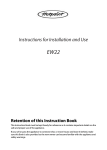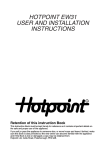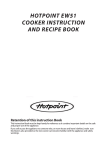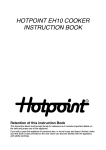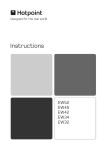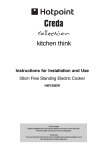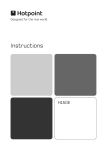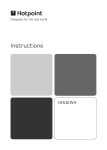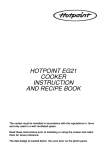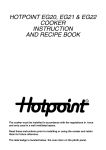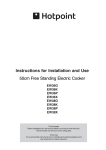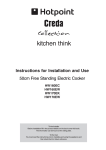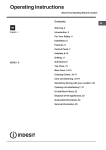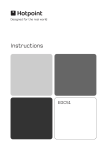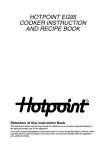Download Hotpoint EW22 User's Manual
Transcript
Instructions for Installation and Use EW22 Retention of this Instruction Book This Instruction Book must be kept handy for reference as it contains important details on the safe and proper use of the appliance. If you sell or pass the appliance to someone else, or move house and leave it behind, make sure this Book is also provided so the new owner can become familiar with the appliance and safety warnings. Contents Introduction Installation 3 4-5 Product Specification For your Safety – Always For your Safety – Never Features Control Panel Using the Hob Temperature Conversion Scale Grilling Oven Cookery Notes Oven Temperature Chart – Meat 6 7 8 9 10 11 13 14 15 17 Oven Temperature Chart – Baking 18 Recipes Care and Cleaning Cooking Results Not Satisfactory Something Wrong with your Cooker Key Contacts This appliance conforms to the following EEC Directives: Low Voltage Equipment 73/23/EEC 93/68/EEC Electromagnetic Compatibility 89/336/EEC 92/31/EEC 93/68/EEC 2 19 22 24 25 Rear Cover Introduction Your new cooker is guaranteed and will give lasting service. This guarantee is only applicable if the appliance has been installed in accordance with the installation instructions detailed in this booklet. To help make the best use of your Hotpoint cooking equipment please read this booklet carefully. The cooker is designed specifically for domestic use and responsibility will not be accepted for use in any other installation. When first using the cooker ensure that the room is well ventilated (e.g. open a window or use an extractor fan) and that persons who may be sensitive to the odour avoid any fumes. It is suggested that any pets be removed from the room until the smell has ceased. This odour is due to temporary finish on oven liners and elements and also any moisture absorbed by the insulation. 3 Installation WARNING – THIS APPLIANCE MUST BE EARTHED. Your cooker should have been checked to ensure that the voltage corresponds with your supply voltage, this is stated on the rating plate, which is situated on the front of the plinth. The cooker must be connected by a competent person such as one who is NICEIC registered, to suitable double-pole control unit with a minimum rating of 45A and a minimum contact clearance of 3mm, which should be fitted adjacent to the cooker, in accordance with latest IEE regulations. The power supply cable should conform to B.S.6004 with a conductor size of 6mm2 minimum. The control unit should be easily accessible in the event of an emergency, but must be within 2 metres of and not directly above an appliance. This appliance conforms to EN 55014 regarding suppression of radio and television interference. Access to the mains terminals is gained by removing the rear access cover. The mains cable must pass through the cable clamp adjacent to the terminal block. Sufficient cable should be used to allow the cooker to be pulled out for servicing. Ensure that the mains cable is routed away from any brackets affixed to the rear panel and is not trapped to the rear wall when pushing the cooker into position between cabinets. The cooker is designed to fit between kitchen cabinets spaced 500mm apart. The space either side need only be sufficient to allow withdrawal of the cooker for servicing. It can be used with cabinets one side or both as well as in a corner setting. It can also be used free-standing. 650 mm Siting the Cooker 150 mm 150 mm This cooker is a type X appliance, as such adjacent side walls which project above hob level, must not be nearer to the cooker than 150mm and should be protected by heat resistant material. Any overhanging surface or cooker hood should not be nearer 650mm. The height of the cooker can be adjusted by means of adjustable feet in the plinth (900mm - 915mm). Adjust the feet by tilting the cooker from the side. Then install the product into position. NOTE: This appliance must not be fitted on a platform. 4 Installation Moving the Cooker Before moving your cooker check that it is cool, and switch off at the cooker control unit. Movement of your cooker is most easily achieved by lifting the front as follows: Open the grill door sufficiently to allow a comfortable grip on the underside front edge of the oven roof, avoiding any grill elements. Note: Take care in moving the cooker as it is heavy. Take care to ensure that any floor covering is not damaged. Splash Panel Kit (Wall Mounted) Splashplate optional, call Hotpoint Genuine Parts & Accessories (see KEY CONTACTS, back page). 5 Product Specification Supply Voltage 230V AC only 240V AC only Supply Frequency 50Hz 50Hz Total Wattage 9.5kW 10.3kW Grill Wattage 1.6kW 1.75kW Main Oven Wattage 2.3kW 2.5kW Left Front Hotplate 1.84kW 2.0kW Left Rear Hotplate 0.9kW 1.0kW Right Rear Hotplate 1.38kW 1.5kW Right Front Hotplate 1.38kW 1.5kW Grilling Area 900cm2 Top Oven Capacity 28 litres Main Oven Capacity 51.5 litres External Dimensions Excluding Handles 6 H 900mm W 500mm D 595mm Safety Information When used properly your appliance is completely safe but as with any electrical product there are certain precautions that must be observed. PLEASE READ THE PRECAUTIONS BELOW BEFORE USING YOUR APPLIANCE. Always ● Remove all packing from the appliance before switching on for the first time. ● Understand the controls prior to using the appliance. ● Keep children away from the appliance when cooking as the surfaces will get extremely hot during and after use. ● Turn controls off when not in use. ● Stand back when opening an oven door to allow any build up of steam or heat to disperse. ● Use dry good quality oven gloves when removing items from the oven/grill. ● Place pans centrally over the hotplate making sure handles are kept away from the edge of the hob and cannot become heated by other hotplates or pans. ● Take care to avoid heat or steam burns when operating the controls. ● Turn off the electricity supply at the wall switch and allow the appliance to cool before cleaning (or changing an oven lamp if fitted). ● Make sure the shelves are in the correct position before switching on the oven or grill. ● Keep the oven/grill door closed when the appliance is not in use. ● Keep the appliance clean as a build up of grease or fat from cooking can cause a fire. ● Follow the basic principles of food handling and hygiene to prevent the possibility of bacterial growth. ● Keep ventilation slots clear of obstructions. ● Refer servicing to a qualified appliance service engineer. ● Take care when removing items from the grill compartment when the lower oven is in use as the contents will be hot ● Turn off the electricity supply to the appliance at the wall switch should any glass panel (if fitted) crack or shatter and then DO NOT USE THE APPLIANCE until repaired. ● During use, the oven becomes hot. Care should be taken to avoid touching heating elements inside the oven. 7 Safety Information Never ● Never leave children unsupervised where a cooking appliance is installed as all surfaces will be hot during and after its use. ● Never allow anyone to sit or stand on any part of the appliance. ● Never store items above the appliance that children may attempt to reach. ● Never leave anything on the hob surface when unattended and not in use. ● Never remove the oven shelves whilst the oven is hot. ● Never heat up unopened food containers as pressure can build up causing the container to burst. ● Never store chemicals/food stuffs or pressurised containers in or on the appliance, or in cabinets immediately above or next to the appliance. ● Never place flammable or plastic items on or near the hob. ● Never fill a deep fat frying pan more than 1/3 full of oil, or use a lid. DO NOT LEAVE DEEP FAT FRYING PANS UNATTENDED WHILE COOKING. ● Never use the appliance as a room heater. ● Never use the grill to warm plates. ● Never dry any items on either the hob or oven doors. ● Never install the appliance next to curtains or other soft furnishings. ● Never operate the grill with the grill door closed as this will cause the appliance to over heat. ● Never use ‘steam cleaners’. SAFETY ADVICE IN CASE OF A CHIP-PAN FIRE In the event of a chip pan fire or any other pan fire. 1. TURN OFF THE COOKER APPLIANCE AT THE WALL SWITCH. 2. COVER THE PAN WITH A FIRE BLANKET OR DAMP CLOTH, this will smother the flames and extinguish the fire. 3. LEAVE THE PAN TO COOL FOR AT LEAST 60 MINUTES BEFORE MOVING IT. Injuries are often caused by picking up a hot pan and rushing outside with it. NEVER USE A FIRE EXTINGUISHER TO PUT OUT A PAN FIRE as the force of the extinguisher is likely to tip the pan over. Never use water to extinguish oil or fat fires. 8 Features HOB VENTILATION SLOTS 1.0kW 1.5kW 2.0kW Red Spot 1.5kW Red Spot CONTROL PANEL GRILL GRILL/MEAT PAN WITH FIXED/DETACHABLE HANDLE AND GRID GRILL DOOR OVEN FAN COOKING STAYCLEAN SIDE PANELS OVEN SHELVES RATING PLATE OVEN DOOR MEAT PAN PLINTH VENTILATION SLOTS 9 Control Panel GRILL INDICATOR LIGHT LEFT FRONT PLATE Control Knobs LEFT REAR PLATE RIGHT REAR PLATE RIGHT FRONT PLATE GRILL OVEN INDICATOR LIGHT OVEN The knobs for the grill and hotplates can be rotated in either direction to provide variable heat control, the Oven knob can only be rotated clockwise from the Off position. Note: Always ensure that all controls are in the OFF position, when the appliance is not in use. Operating the control when the grill is in use In common with all cookers having controls sited above the grill compartment, care must be taken when setting the controls, due to hot air being emitted from the grill compartment. Cooling Fan A gentle flow of air will be blown below the control panel when the grill/oven is in use. This is a safety feature that ensures the control panel surface and control knobs are kept cool. 10 Using the Hob Hob Controls Each control can be used to select one of six temperature settings from position 1 (minimum) to position 6 (maximum). For normal cooking, after having placed the pan on the required hob position, set the control knob to 6 (maximum), wait until boiling point is reached, then set the control knob to a lower position as required. Use of Hotplates The front red spot hotplates heat up more rapidly than the other hotplates. Use the red spot plates to give faster boiling times. Turn the control knob to 6 for fast cooking. To reduce the heat, to cook more slowly or simmer, turn the knob to a lower setting which will vary according to the size of the saucepan, the quantity of food and whether a lid is being used. The two small hotplates are specially for smaller pans, low temperature cooking and simmering. WARNING: Do not leave anything on the hob when it is not in use. Never leave a hotplate switched on without a pan as this wastes energy and will shorten the life of the hotplate. See chart below for guide to control settings. Control Settings Guide This table is provided only as a guide – settings also depend on the type of pan used and the quality of food. Knob Position 1 1 or 2 3 4 or 5 5 or 6 6 Type of food To melt butter, chocolate, etc. To heat food gently. To keep small amounts of water simmering. To heat sauces, containing egg yolks and butter, To simmer: stews, meat, fish, vegetables, fruit. To heat solid and liquid foods. Keep water boiling. Thaw frozen vegetables. Make 2-3 egg omelettes. To cook foods, just above simmering. To maintain 'rolling' boil for preserve making. To seal meat and fry fish. Frying potatoes. Bringing water to the boil. Deep fat frying. Dissolve sugar for preserve making. 11 Using the Hob Choosing your Utensils For best results we recommend the use of good quality saucepans with smooth flat bases. Aluminium pans with coloured vitreous enamelled bases absorb heat and are more efficient in use. Almost equally as good are saucepans with a thick machines aluminium base. If using enamelled steel or cast iron pans, ensure that they have good smooth flat bases, otherwise the heat will not be distributed evenly and damaging heat spots may be created. Never use recessed or ridged base utensils. Ideally the base of the saucepan should be approximately the same size as the heating area, up to a maximum of 254mm (10"). Use pans which have sufficient capacity for the amount of food being cooked and therefore reduced soiling caused by excessive spillage. Do use utensils with good fitted lids and for best results use a low dome pressure cooker. Remember 1. 2. Purchasing a new pan will not necessarily mean it will have a flat base. Always check before buying. Using the correct pan will result in maximum contact with the hotplate and maximum efficiency. IMPORTANT: As there could be a fire risk attached to the heating of oil, particularly Deep Fat Frying, DO NOT leave cooking utensils containing oil unattended (eg. to answer the telephone) on or in close proximity to hotplates. Safety requirements for deep fat frying 12 The following recommendations should be followed. 1. Never leave the pan unattended on the heat eg. to answer the telephone. 2. Always use a deep pan, large enough to cover the cooking zone. 3. Never fill the pan more than one third full with oil or fat. On no account mix oil and fat. 4. Do not overload the pan by trying to fry too much. The pan containing oil and food should be no more than two thirds full. 5. Always dry food thoroughly before frying and lower it slowly into the oil. 6. Do not use a lid on the pan. 7. Always keep the outside on the pan clean and free from fat and oil. 8. Do not allow excessive splashing of oil onto the hob. Temperature Conversion Scale Comparative scale of oven settings (degrees Celsius to degrees Fahrenheit) as recommended by the Association of Manufacturers of Domestic Electrical Appliances. The temperature control knobs on this electric cooker are marked in degrees Celcius. This chart will help when the recipes show alternative scales. Fan Oven Convection Oven Gas Mark (It is not always necessary to preheat oven) ˚F ˚C ˚C /2 250 120 100 1 275 140 120 2 300 150 130 3 325 160 140 4 350 180 160 5 375 190 170 6 400 200 180 7 425 220 200 8 450 230 210 9 475 240 220 1 13 Grilling CAUTION: ACCESSIBLE PARTS WILL BECOME HOT WHEN THE GRILL IS USED - CHILDREN SHOULD BE KEPT AWAY. GRILLING SHOULD NOT BE UNDERTAKEN WITH THE GRILL DOOR CLOSED. Open the grill door. Pre-heat the grill on setting 6 for approximately 5 minutes. When toasting / grilling push the pan back to correctly position it under the grill element. Leave the control at 6 for toast, for sealing and fast cooking of foods. For thicker foods requiring longer cooking, turn the control to a lower setting, after the initial sealing on both sides at setting 6. The thicker the food, the lower the control should be set. When grilling thicker food, the wire grid should be turned over to its lowest setting. Food which requires browning only should be placed under the hot grill, either in the grill pan or on the floor of the grill compartment, according to the depth of the dish. (The grill pan wire grid can be removed). DO NOT line the grill pan with aluminium foil. Grill Pan Handle The grill pan handle is detachable so that it may be used in the oven as a meat pan and also to facilitate cleaning and storage. For a detachable handle remove the screw and washers from the grill pan and discard. If you require a fixed handle, fix the grill pan handle securely in position before use. To do this remove the screw and washers from the grill pan bracket, tilt the handle over the recess adjacent to the bracket (A) and slide the handle towards the centre of the pan (B), ensure the handle is fully located over the bracket (C). Replace screw and washers and ensure that they are fully tightened. Note: If a fixed handle is required the grill pan cannot be used in the oven. A Grill compartment as a ‘Hotcupboard’ 14 B C Plates and dishes placed on the floor of the grill compartment will be heated when the oven is in use. Do not operate the grill control when using the compartment as a hotcupboard. You may need to use oven gloves when removing warmed items. Oven Cookery Notes The oven is fitted with ‘Stayclean’ liners, two rod shelves and a meat pan. Remove the meat pan if it is not being used. To heat the oven, turn the control knob clockwise, selecting the required temperature between 80˚C (175˚F) and 230˚C (450˚F) as recommended in the temperature chart. The indicator light will immediately come on and remain on until the oven reaches the required temperature. This light will then automatically go off and on during cooking as the oven thermostat maintains the correct temperature. It should be noted that at the end of a cooking period there may be a momentary puff of steam when the oven door is opened. This will disperse in a few seconds and is a perfectly normal characteristic of an oven with a good door seal. Since a fan oven heats up more quickly, and generally cooks food at a lower temperature than a conventional oven, preheating the oven is often unnecessary. However food such as bread, scones, Yorkshire pudding, do benefit from being placed in a pre-heated oven. The charts on pages 17 and 18 are a guide only, giving approximate cooking temperatures and times. To suit personal taste and requirements, it may be necessary to increase or decrease temperatures by 10˚C. Unless otherwise indicated in the charts, food is placed in a cold oven, i.e. without pre-heating. If food is placed in an already hot oven, the suggested cooking time should be reduced, depending on the type and quantity of food being cooked. Oven Positions Since the distribution of heat in the circulaire ovens is very even, most foods will cook satisfactorily on any shelf position, but the shelves should be evenly spaced. Do not fit shelves upside down. Additional shelves can be purchased through your oven supplier or Spares Centre. Never use more than 3 shelves in the oven as air circulation will be seriously restricted. To ensure even circulation do not use meat pans larger than 390 x 300mm (15" x 12") and baking trays no larger than 330 x 255mm (13" x 10"), these should be positioned centrally on the oven shelf. Food should not be placed directly on the floor of the oven. To avoid unnecessary cleaning, rod shelves which are not in use should be removed from the oven. Temperature and Time When three shelves are used to cook large quantities of food for home freezing or parties, it may be necessary to increase the cooking times given in the charts on pages 17 and 18 by a few minutes, to allow for the loss of heat due to the extra time taken to load the oven, and the larger mass of food. Baking trays should allow an equal gap at either side of the oven. N.B. Recipes in cookery books give times and temperatures for cooking in ordinary ovens. The introduction of improved thermal insulation on fan ovens makes it possible, in most cases, to reduce (a) the recommended temperature by 25˚C (45˚F) and (b) the recommended time by approximately 10 minutes per hour. 15 Oven Cookery Notes To prepare meat and poultry for roasting in your fan oven. (a) Wipe the meat or poultry, dry well and weigh it. Meat which has been stored in a refrigerator should be allowed to come to room temperature before cooking, and frozen meat or poultry must be completely defrosted before placing in the oven. (b) The weight of any stuffing used should be added before calculating the cooking time. (c) Place meat/poultry in the meat pan supplied with your cooker. Small joints weighing less than 1.75kg (3 1 / 2 lbs) should be roasted in a smaller meat pan/tin - or they may be 'pot roasted' a small joint in a large meat pan causes unnecessary oven splashing and evaporation of meat juices. (d) Additional fat should not be added, except for veal, very lean meat or poultry which can either be 'larded' with fat bacon or brushed very sparingly with cooking oil or melted fat. (e) Beef, lamb, mutton and poultry may be dusted lightly with seasoned flour to give a crisp outer surface. The skin of duck and goose should be pricked to release excess fat during cooking, and the rind of pork should be scored, brushed lightly with oil, and rubbed with salt, to give crisp crackling. (f) Meat and poultry wrapped in, or covered with a tent of aluminium foil will be juicy and tender. Roasting bags offer the same advantages. Always follow the manufacturers pack instructions, and remember to reduce the temperatures given for conventional ovens by approximately 25˚C and the time by approximately 10 minutes per hour. (g) Potatoes for roasting only require to be brushed with cooking oil or melted fat. (h) It is not necessary to baste when roasting in an electric oven and stock or liquid should not be added to the meat pan since this only causes unnecessary soiling, steam and condensation. Frozen Meat and Poultry Joints of meat and whole birds should be defrosted slowly, preferably in a domestic refrigerator (allowing 5 - 6 hours per 450g, 1lb), or at room temperature (allowing 2-3 hours per 450g, 1lb). If however, it is found necessary to accelerate this process, frozen food can be defrosted in the fan oven at a temperature of 80˚C (175˚F). A 1.5kg (3lb) oven ready frozen chicken, placed in the meat pan, will defrost in approximately 11/2 – 13/4 hours. The breast should be covered with foil, held in position by skewers or string, and the giblets removed after defrosting but before cooking. THIS METHOD OF DEFROSTING IS ONLY RECOMMENDED FOR MEAT/POULTRY UP TO 2kg (4lb) IN WEIGHT, AND IT IS ESSENTIAL TO COOK IT THOROUGHLY, IMMEDIATELY AFTERWARDS. 16 Oven Temperature Charts – Meat Fan Oven Cooking Meat Preheat Temperature o C Time (approx.) Beef No 160/180 20-25 mins per 450g (1 lb) + 20 mins extra Lamb No 160/180 25 mins per 450g (1 lb) + 25 mins extra Pork No 160/180 25 mins per 450g (1 lb) + 25 mins extra Veal No 160/170 25-30 mins per 450g (1 lb) + 25 mins extra Chicken/Turkey up to 4kg (8 lb) No 160/180 18-20 mins per 450g (1 lb) + 20 mins extra 150/160 150 13-15 mins per 450g (1 lb) e.g. 5kg (1 lb) = 143-165 mins 12 mins per 450g (1 lb) e.g. 10kg (22 lb) = 264 mins 140-150 11/2 - 2 Hrs Turkey up to 5.5kg (12 lb) No over 5.5kg (12 lb) Casserole Stews No If using aluminium foil, never: 1. Allow foil to touch sides of oven. 2. Cover oven interior with foil. 3. Cover shelves with foil. The most accurate method of testing the readiness of joints of meat or whole poultry is to insert a meat thermometer into the thickest part of a joint, or the thickest part of poultry thighs, during the cooking period. The meat thermometer will indicate when the required internal temp has been reached. Beef – Rare: 60oC Medium: 70oC Well Done: 75oC Lamb: 80oC Pork: 90oC Veal: 75oC Poultry: 90oC 17 Oven Temperature Charts – Baking Fan Oven Cooking Baking Food Preheat Temperature o C Time in mins. Scones Yes 210/220 9-12 Small Cakes 170/180 15-20 Victoria Sandwich 160/170 20-25 Sponge Sandwich Yes 170/190 15-20 Swiss Roll Yes 180/200 12-15 Semi-rich Fruit cakes 140/150 75-90 Rich Fruit Cakes 130/140 Time dependent on recipe. Shortcrust Pastry 190/200 45-50 Puff Pastry 190/200 Time dependent on recipe. Yorkshire Pudding Yes 180/190 40-45 Individual Yorkshire Puddings Yes 190/200 20-25 Milk Pudding 130/140 105-135 Baked Custard 140/150 40-50 200/210 45-50 70-90 180-240 Bread Meringues Yes Note: If soft margarine is used for cake making, temperatures recommended by the manufacturers should be followed. Temperatures recommended in this chart refer to cakes made with block margarines or butter only. 18 Recipes For Fan Oven BEEF STEW AND DUMPLINGS 675g (11/2 lb) stewing steak, cut into 2.5cm (1 in. cubes) 2 medium sized onions, peeled and quartered 225g (8oz) carrots, peeled and sliced 225g (8oz) swede, peeled and cubed 4 sticks of celery, cut into 2.5cm (1 in.) lengths 500ml (1 pint) beef stock, boiling 30ml (2 tbsp) tomato puree 5ml (1 tsp) mixed dried herbs Salt and pepper Dumplings: 100g (4oz) self raising flour Pinch of salt FRUIT PLATE TARTS Pastry: 800g (13/4 lb) plain flour 200g (7oz) block margarine 200g (7oz) cooking fat 250ml (10fl oz) cold water Filling: 675g (11/2 lb) prepared fruit 50g (2oz) sugar 1. Make pastry. Sift flour into bowl, rub in fats until mixture resembles fine breadcrumbs. 2. Gradually add cold water to bind pastry together to form stiff dough. RICE PUDDING 40g (1 /2 oz) pudding rice 25g (1oz) sugar 500ml (1 pint) milk Grated nutmeg 50g (2oz) sultanas or raisins (optional) 1 50g (2oz) shredded suet 15ml (1 tbsp) chopped parsley Cold water to mix 1. Place meat, vegetables, stock, puree, herbs and seasoning in large casserole dish. 2. Cover dish. 3. Bake: 140˚C; 11/2-2 hours. 4. Cook until meat is tender. 5. Make dumplings: mix flour, salt, suet and parsley together in bowl. 6. Add enough water to make soft dough. 7. Divide into 4 pieces, from each into ball and place on top of stew. 8. Cover and continue to cook for further 20-30 minutes or until cooked through. 3. Turn onto lightly floured surface. Knead lightly then divide pastry into four equal pieces. 4. Roll out two pieces to line base of two 25cm (10in) plates. Roll out remaining two pieces and leave to one side. 5. Prepare fruit for filling. Divide equally between the two pastry lined plates, adding the sugar. 6. Dampen edges of pastry with water. Cover fruit with rolled out pastry. 7. Trim and seal edges. Make a slit in the top of the pastry. 8. Bake: 190˚C; 35-45 mins. 1. Grease pie dish and put in rice and dried fruit (if used). 2. Add sugar and milk, stir well, sprinkle grated nutmeg on top. 3. Bake: 140˚C; 11/2 – 2 hours. 19 Recipes For Fan Oven BATTERS Basic Recipe: 100g (4oz) plain flour Pinch of salt 1 large egg 250ml (1/2 pint) milk and water mixed in equal quantities 1. Sieve flour and salt into basin. 2. Make a well in centre and add egg plus one-third of liquid. 3. Beat well until mixture is smooth. 4. Add another third of liquid and again beat well until smooth. 5. Lightly stir in remaining liquid. 6. If possible, allow batter to stand in cool place for at least half an hour. YORKSHIRE PUDDING 1. Place 25g (1oz) dripping into shallow ovenproof dish or 22.5cm (9in) square Yorkshire pudding tin and place in top of oven to heat for 10 minutes. 2. Pour batter into hot fat. 3. Bake: preheat; 180oC; 35-45 mins. ALL-IN-ONE VICTORIA SANDWICH 100g (4oz) soft tub margarine 100g (4oz) caster sugar 2 eggs 100g (4oz) self raising flour 5ml (1 tsp) baking powder VICTORIA SANDWICH 100g (4oz) block margarine 100g (4oz) caster sugar 2 eggs 100g (4oz) self raising flour 20 1. Place all ingredients into a bowl. 2. Beat with a wooden spoon for 2-3 minutes or beat in electric mixer for 1 minute. 3. Grease and line two 18cm (7in) sandwich tins. 4. Place mixture into prepared tins. 5. Bake: 150-160˚C; 20-30 mins. 1. Cream margarine and sugar until light, fluffy and pale in colour. 2. Beat in eggs. 3. Sift flour and fold into mixture. 4. Grease and line two 18cm (7in). sandwich tins. 5. Divide mixture equally into tins. Level tops. 6. Bake: 160-170˚C; 20-30 mins. 7. Bake until well risen, golden brown and firm to touch. Recipes For Fan Oven CHRISTMAS CAKE 225g (8oz) butter or block margarine 225g (8oz) brown sugar 4 eggs 225g (8oz) plain flour 5ml (1 tsp) mixed spice 2.5ml (1/2 tsp) baking powder 200g (7oz) raisins 200g (7oz) sultanas 200g (7oz) currants 50g (2oz) chopped almonds 75g (3oz) glace cherries (cut in pieces) 60ml (4 tbsp) brandy (optional) SMALL CAKES 225g (8oz) block margarine 225g (8oz) caster sugar 4 eggs 300g (11oz) self raising flour Variations: 100g (4oz) sultanas 100g (4oz) chocolate chips 100g (4oz) chopped glace cherries 30ml (2 tbsp) cocoa powder mixed to paste with water Add any of the above with flour SCONES 450g (1lb) plain flour 10ml (2 tsp) cream of tartar 5ml (tbsp) bicarbonate of soda 100g (4 oz) block margarine 225ml (8 fl oz) milk Variations: Sultana scones – add 100g (4 oz) sultanas and 50g (2oz) caster sugar Wholemeal scones – use half quantity of wholemeal flour Cheese scones – add 100g (4oz) grated cheddar cheese and 5ml (1 tsp) dry mustard 1. Cream fat and sugar until light and fluffy. 2. Add eggs one at a time, beating well. 3. Sieve dry ingredients. Add gradually with mixed fruit, cherries and nuts. 4. Bake in lined 20cm (8in) cake tin: 130˚C; 21/2-3 hours. It may be necessary to cover top of cake with brown paper for final hour to prevent over browning. 5. Leave in tin to cool a little, before turning out. 6. When cold, prick bottom of cake and sprinkle brandy over. Leave for about a week before icing. 1. Cream margarine and sugar until light, fluffy and pale in colour. 2. Add each egg, beating well after each addition. 3. Fold in sifted flour, mixing well. 4. Place paper cases on baking trays and two-thirds fill them with mixture. 5. Bake until golden brown and springy to touch: 170˚C; 15-20 mins. 1. Sift together flour, cream of tartar and bicarbonate of soda. 2. Rub in margarine until mixture resembles fine breadcrumbs. 3. Make a well in centre. Stir in enough milk to give fairly soft dough. 4. Turn onto lightly floured surface. Knead lightly to remove any cracks. Roll out to about 15mm ( 3/4 in). Cut out 5cm (2in) rounds. Place on baking sheet. 5. Knead remaining dough and re-roll. 6. Bake until well risen and golden brown; preheat; 210˚C; 9-12 mins. 21 Care and Cleaning TURN OFF THE MAIN SWITCH BEFORE CLEANING. BEFORE SWITCHING ON AGAIN, ENSURE THAT ALL CONTROLS ARE IN THE OFF POSITION. NEVER USE BIOLOGICAL WASHING POWDER, HARSH ABRASIVES, SCOURING PADS, AEROSOL CLEANERS OR OVEN CHEMICAL CLEANERS OF ANY KIND. Vitreous Enamel Hob Clean with a cloth wrung out in warm soapy water. Stubborn stains can be removed with a cream paste or liquid cleaner or by gently rubbing with a Surround fine steel wool soap pad eg. ‘Brillo’, etc. Check that the cleaning agent used is approved by the Vitreous Enamel Development Council. Sealed Hotplates The cleaning of sealed hotplates should be done when they are cold, using a soap filled ‘Brillo’ pad, following the grain of the hotplate. This will ensure that any stubborn, burnt on stains and spillages are removed. Wipe over with a damp clean cloth, making sure that all the cleaner residue has been removed. The bezels will mellow with use to a burnished gold colour, a soap filled ‘Brillo’ pad will help to keep them bright, care should be taken not to damage the vitreous enamel hob surface. Finally turn on the hotplate to warm for a few minutes, then smear a little cooking oil to provide a protective coating, or use a restorative agent such as Collo Electrol® (PART NO. 640001). This can be ordered from Hotpoint Genuine Parts & Accessories (see KEY CONTACTS, back page). Control panel Wipe with a damp cloth and polish with a dry cloth. Do not use cream cleaners, oven cleaners or aerosols, scouring pads or abrasive powder for cleaning the plastic knobs as damage will occur. Grill Remove the grill pan and the wire grid food support, it is best to wash these items immediately after use to prevent stains from being burnt on when used again. Wipe out the grill/Top oven compartment, use a fine steel wool soap pad to remove stubborn stains from the rod shelf, grill deflector plate and the floor of the compartment. Doors Wipe over the door outer glass panel with a cloth wrung out in warm soapy water, then after wiping with a cloth wrung out in clear water, dry with a soft clean cloth. DO NOT use scouring pads or abrasive powder which may scratch the surface. Take care during cleaning not to damage or distort the door seals. Do not lift the door seal from the oven chassis, if necessary remove the seal by carefully unhooking the corner clips. 22 Care and Cleaning Oven Remove the rod shelves and meat pan. Use a fine steel wool soap pad to remove stubborn stains from the rod shelves, meat pan and the floor of the oven. How ‘Stayclean’ Works The surface of the ‘Stayclean’ oven liners are treated on the mottled face with a special vitreous enamel which absorbs cooking soils. At temperatures of 220oC (425oF) or above, the special surface enables these soils to be slowly destroyed. The higher the temperature the more effective it is. In most cases normal cooking operation at this temperature will permit this cleaning operation to proceed during cooking. However if higher cooking temperatures are not used regularly it may be necessary, to prevent heavy soiling, to run the oven without a meat pan at maximum setting for a couple of hours. This may be necessary once a month or once every two or three months depending on the type and amount of oven cooking. Oven Liners - sides It should not normally be necessary to clean the ‘Stayclean’ panels in water. If desirable, remove the rod shelves and the side panels and wash them in warm soapy water, followed by a rinse in clean water. Cleaning the Exterior of the Cooker The outside of the cooker should be cleaned regularly to keep it looking like new. Wipe over with a soft cloth wrung out in warm water and dry with a soft clean cloth. You can use mild non-abrasive cleaners but always read the manufacturer’s instructions first. Always test their suitability on a small area of the cooker not noticable in normal use. NOTE: Do not use scouring pads or abrasive cleaners which may scratch the surface. Wear protective gloves when cleaning any part of your cooker. 23 Cooking Results Not Satisfactory? Problem Check Grilling Uneven cooking front to back Ensure that the grill pan is positioned centrally below the grill element. Fat splattering Ensure that the grill is not set to too high a temperature. Oven Baking Uneven rising of cakes Ensure that the oven shelves are level by using a spirit level on the rod shelf and adjusting, using suitable packing e.g. wood, under the feet of the appliance. This should be checked both left to right and front to back. Ensure that the food is positioned centrally in the oven. The following may cause cakes to sink: 1. Preheat of fan ovens. 2. Cooking at too high a temperature. 3. Using normal creaming method with soft margarine. Sinking of cakes Over/Under cooking Fast/Slow cooking Nothing Works Refer to the cooking times and temperatures given in the oven temperature charts, however, it may be necessary to increase or decrease temperatures by 10oC to suit personal taste. Do not use utensils greater than 56mm (21/4") in height, for roasting. Is the main cooker wall switch turned on? There may be no electricity supply. Grill does not work. Main oven works. Operating the cooker under the following conditions may cause a safety cut-out to operate: a) grilling with the top oven door shut. b) grilling for excessive long periods at maximum settings. Switch off the appliance and allow the cooker to cool for approx. 30 minutes. Switch the cooker back on again and check that the grill is now operating correctly. Grill keeps turning on and off. When the grill control is operated at a setting less than maximum, this is normal regulator operation, not a fault. 24 Something Wrong with your Cooker? Before contacting your Service Office/Installer, check the problem guide below. Problem Check Slight odour or small amount of smoke when using the cooker for the first time. This is normal and should cease after a short period. Cooker does not work at all. Check that the switch on the control unit is in the on position. If so check that the main fuse has not blown. Oven temperature seems too high or too low. Check that the temperature has been set in accordance with the temperature charts. It may be necessary to increase or decrease the recommended temperature by up to 10oC to suit your taste. Oven does not cook evenly. Check that the temperature and shelf position are as recommended in the temperature charts. Check that the containers being used in the oven allow sufficient air flow around them. Check that the cooker is level. Hotplates are slow to boil or will not simmer. Check that your pans conform to the recommendations in these instructions. Grilling is uneven. Check that the grill pan has been correctly positioned. Draught from the control panel when the oven is switched on. A gentle flow of air will be blown from beneath the control panel when the oven is is use. The fan will stop when the control has been turned off. 25 Spare Parts Please remember your new appliance is a complex piece of equipment. ‘DIY’ repairs or unqualified and untrained service people may put you in danger, could damage the appliance and might mean you lose cover under Hotpoint’s Parts Guarantee. If you do experience a problem with the appliance don’t take risks; call in Hotpoint’s own Service Engineer (see KEY CONTACTS, back cover). Our spare parts are designed exclusively to fit only Hotpoint appliances. Do not use them for any other purpose as you may create a safety hazard. Disposal of your Product To minimise the risk of injury to children please dispose of your product carefully and safely. Remove all doors and lids (where fitted). Remove the mains cable (where fitted) by cutting off flush with the appliance and always ensure that no plug is left in a condition where it could be connected to the electricity supply. To help the environment, Local Authority instructions should be followed for the disposal of your product. 26 Hotpoint Service Cover Satisfaction Guaranteed or Your Money Back Hotpoint gives you a unique ‘Satisfaction Guaranteed’ promise – valid for ninety days after you have purchased your Hotpoint product. If there is a technical problem with your Hotpoint appliance, just call Hotpoint Service (see back page). If necessary we will arrange for an engineer to call. If the technical problem is not resolved under this Guarantee, Hotpoint will replace your appliance or, if you prefer, give you your money back. Your statutory rights are not affected, and the Guarantee is additional and subject to the terms of Hotpoint’s Five Year Parts Guarantee. Hotpoint’s Free Five Year Guarantee From the moment your appliance is delivered Hotpoint guarantees it for FIVE YEARS. • In the Five Years all replacement parts are FREE provided that they are fitted by our own Service Engineer. During the first year our Engineer’s time and labour is also free. • Our guarantee covers loss of food in our refrigeration and freezer products up to £250 during the first year, subject to verification by one of our engineers. • After the first year we will charge for our Engineer’s time and labour. We do, however, operate a range of Service Plans (see opposite) which, for an annual payment, enables you to cover any repair costs which may be necessary. • All our service repairs are guaranteed for twelve months in respect of our labour and any parts fitted. • The appliance must be used in the United Kingdom, and must not be tampered with or taken apart by anyone other than our own Service Engineers. • You may, however, buy parts which can be safely fitted without specialist knowledge or equipment. The correct fitting of such parts, provided they are genuine Hotpoint spares, will not affect your Guarantee. Parts are available from our Hotpoint Spares Centres (see back page). • Our guarantee does not cover the cost of any repair, or loss of food in refrigeration products, due to power failure, accidents or misuse. Nor does it cover the cost of any visits to advise you on the use of your appliance. Please read thoroughly the instruction book supplied with this appliance. • If at any time during the Guarantee period we are unable to repair your appliance, we will refund any repair costs paid to us in the previous twelve months. We will also offer you a new appliance at a reduced charge instead of a repair. • Our Guarantee is in addition to and does not affect your legal rights. • Should you need independent advice on your consumer rights, help is available from your Consumer Advice Centre, Law Centre, Trading Standards Department and Citizens Advice Bureau. • All Hotpoint servicing is carried out by our own Service Organisation located throughout the United Kingdom and Eire. We will be happy to deal with any problems which you may have. Hotpoint’s Extended Warranties Whether you have just one or a number of Hotpoint appliances in your kitchen, Hotpoint has a range of Service Plans to give you complete peace of mind.They enable you to extend your one year labour guarantee so that you can have repairs completed FREE during the membership period. Service Cover We offer a number of payment methods; cheque, credit card or you can spread the cost and pay by direct debit (full details can be obtained on Free phone 0800 716356). This covers you for all repairs during the period of cover, which can be from 1 to 4 years. Service Cover also includes loss of food, up to the value of £250, in refrigeration appliances. There is also an option of Service Cover with Maintenance at an additional cost. This includes an annual Electrical and Safety check and replacement of any parts as necessary. Kitchen Cover An annual payment covers you for all repairs for all your Hotpoint appliances which are less than ten years old. It also covers the cost of loss of food up to £250 in our refrigeration and freezer products. There is also the option of Kitchen Cover with Maintenance at an additional cost. Any additional Hotpoint appliances purchased after you have joined Hotpoint Kitchen Cover will automatically be included during the annual period of cover without further charge. Appliance Registration To ensure that you have the opportunity to benefit from any of the above Service Schemes and other offers you should complete and return immediately the Appliance Registration Form/Questionnaire supplied with this appliance. Full details and costs of our Service Schemes, together with an application form, will be sent to you at the end of the first year of the guarantee. Annual Safety/Maintenance Checks Hotpoint strongly recommends that all its appliances are regularly checked for electrical and mechanical safety, whether or not they are covered by a Service Plan. Worn door gaskets or hoses may cause a leak on an appliance, which could become dangerous if neglected. Proof of Purchase For future reference please attach your purchase receipt to this booklet and keep it in a safe place. Spares and Accessories Spares and accessories can be ordered from your local Hotpoint Spares Centre (see back page), using the order form enclosed. NOTE: Our Engineers will use every effort to avoid damage to floor coverings and adjacent units when carrying out repairs/service work, but in locations where the Engineer advises you that it will be impossible to move appliances without risk of damage, he will only proceed with your approval that no liability is accepted. 27 Key Contacts Service Hotpoint has the largest appliance manufacturer’s service team in Europe, trained specialists directly employed by us to ensure your complete confidence. Repair Service UK: 08709 066 066 Republic of Ireland: 1850 302 200 You will be asked for the following information:Name, address and postcode. Telephone number Model / Serial number of the appliance Clear and concise details of the query or fault Place and Date of purchase (Please keep the receipt as evidence will be required when the engineer calls). Extended Warranty To join: UK 08709 088 088 Republic of Ireland: 1850 502 200 Genuine Parts & Accessories Mail Order Hotline UK: 08709 077 077 Republic of Ireland: (01) 842 6836 For further product information 08701 50 60 70 All Hotpoint Services are offered as an extra benefit and do not affect your statutory rights. General Domestic Appliances Limited, Morley Way, Peterborough, PE2 9JB PRINTED BY SIMLEX . FOUR ASHES, WOLVERHAMPTON July 2002 Part no. 4966200047-01




























